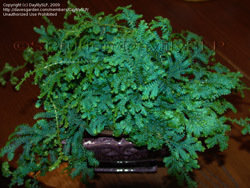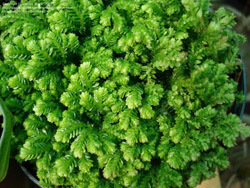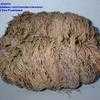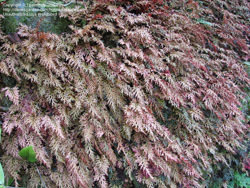





Every once in a while the gardener discovers, quite by accident, one plant or another that becomes an all-time favorite. Such is my experience with arborvitae fern (Selaginella braunii). My introduction to this plant happened a few years back when I visited the garden of a neighbor. I was smitten from the beginning.
On the day of my visit, my neighbor showed me a beautiful mass of plants growing in a container. She called it Selaginella.That was easy for me to remember because my neighbor's name is Sally, and my sister-in-law's name is Gennella. Put the two together, and you have sallygennella, which is close enough to help me remember the generic name.
Selaginella braunii (Arborvitae Fern)
Even though this plant has arborvitae fern as its common name, it is not a fern at all, but is a prehistoric fern relative called club moss or spike moss. Since it is a vascular plant that produces spores, it is often mistaken for a fern. Scaly foliage resembles that of arborvitae or cedar. Fronds of finely dissected foliage look delicate, but quite the opposite is true. Arborvitae fern is a tough, hard-working plant that fulfils its groundcover role quite admirably.
Several years ago I planted three one-gallon containers of arborvitae fern in my garden. Gradually it has grown to cover the ground with a solid mass that inhibits weed growth and remains attractive year round. In fall it turns a rusty color, and often, by spring it turns tan after hard frosts kill the above-ground portion of the plant.
Experimentation has taught me to leave the winter-burned foliage to its own devices. This past year, I mowed about half of the arborvitae fern and left the other half as it was. Spring brought about a new flush of growth that soon covered both areas. I was hard-pressed to tell which side had been mowed. From now on I won't bother with the extra work involved in mowing the area.
Planting and Caring for Arborvitae Fern
Site arborvitae fern in a moist but well drained spot in shade to part shade. Amend sand or heavy clay soil by incorporating a two- or three-inch layer of compost or humus. Plant quart or gallon-sized containers a foot or so apart. Water as needed to maintain damp soil. Fertilize in early spring just as new growth begins with all-purpose, slow-release fertilizer.
The club mosses can be divided easily at any time of year. Simply separate mature clumps and replant the divisions. Cuttings root easily if inserted in soil and kept damp. It is also possible to grow from spores.
Other Species of Selaginella
The GRIN website lists 33 species of Selaginella, although other references list 56 or more. Some accounting for the differences in opinion has to do with the taxonomic splitters who separate plants into different species based on very minute differences. and the lumpers who tend to group plants with similar traits into one species. All agree that the family is Selaginellaceae, and Selaginella is the only genus in the family.
 Peacock fern (Selaginella uncinata), also sometimes known as blue spike-moss or rainbow fern, is a diminutive (6 inches tall, spreading to 2 feet) club moss noted for its bluish green iridescent leaves. It is hardy from zones 6 to 10.
Peacock fern (Selaginella uncinata), also sometimes known as blue spike-moss or rainbow fern, is a diminutive (6 inches tall, spreading to 2 feet) club moss noted for its bluish green iridescent leaves. It is hardy from zones 6 to 10.
Gemmiferous spikemoss (Selaginella moellendorffii) (zones 7 to 10) is an easy-to-grow species from China that bears tiny plantlets that drop off and form new colonies. Dave's Garden PlantScout lists four sources for this plant. 
Golden club moss (Selaginella kraussiana) is a popular species. Native to South Africa, this small, creeping species forms dense mats of green foliage. Some cultivars, with such apt names as ‘Aurea' and ‘Gold Tip' have golden yellow leaves and stems, or stems tipped with bright, lime green.
 Several species are native to the United States and Canada, and like those from other parts of the world, they vary from wetland species to those that grow in dry deserts, such as Selaginella lepidophylla (flower of stone). Sometimes sold as a novelty plant in its dry state, this "resurrection plant" turns green when water is added.
Several species are native to the United States and Canada, and like those from other parts of the world, they vary from wetland species to those that grow in dry deserts, such as Selaginella lepidophylla (flower of stone). Sometimes sold as a novelty plant in its dry state, this "resurrection plant" turns green when water is added.
 Red spike-moss or rock spike moss (Selaginella rupestris) is native to all of the eastern United States and the Southern Canadian provinces. Threatened in Indiana and presumed extirpated in Ohio, the range of this spike moss is sporadic and limited to mostly rocky places.
Red spike-moss or rock spike moss (Selaginella rupestris) is native to all of the eastern United States and the Southern Canadian provinces. Threatened in Indiana and presumed extirpated in Ohio, the range of this spike moss is sporadic and limited to mostly rocky places.
The ornamental Selaginellas look great in hanging baskets or in containers skirting taller plants. Small selections are useful in terrariums. It is excellent in front of taller shade plants such as caladium, aspidistra, and impatiens.
Following the visit to my neighbor's garden, I began to notice Selaginella in garden centers. Keep your eyes open as you visit your favorite nurseries, and investigate on-line sources. You may find several species that would make great additions to your garden.
At a Glance
Selaginella braunii
Say: sell-lah-gi-NEL-uh BRAUN-e-eye
Family: Selaginellaceae (Spikemoss Family)
Other names: Arborvitae fern, club moss, spike moss
Origin: Tropical America, Asia, South Africa, Australia
Zone: 6-10 Light: Shade Water Use Zone: Average
Size: 12 to 18 inches tall
Soil: Organic Salt Tolerance: None
Thanks to the following DGers for the use of their photographs: Daylily for Selaginella uncinata, Arsenic for S. lepidophylla, Palmbob for S. rupestris, CactusLover for S. kraussiana
Copyright © www.100flowers.win Botanic Garden All Rights Reserved